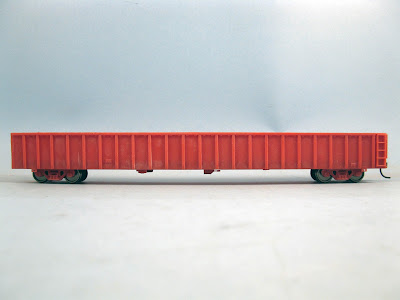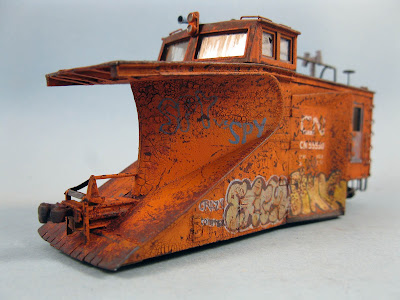With the crackle effects now in place, the basic coat of color and washes applied, it is time to go to the next level with this project, including a lot of distressing. Many other layers will be required to get the desired results.
 |
| This is how it should look... |
The first step to finish the model is to apply decals. But with such an uneven surface, you can forget about a coat of gloss to take care of air bubble. Also, the surface is so rough you have very little leeway in moving around the decals because they can tore at every move. For this purpose, I'm using
Highball Graphics decal set #F-377 which are a good match for my particular prototype. However, it became obvious the plow in Clermont has some different texts on it that weren't in the decals, so I had to fudge a little bit to make sure everything was there. It isn't a criticism of the set which covers most usual variation found on CN snow plow, but it shows us how CN shops would had different letterings after plow were refurbished. Variation is almost infinite.

To make the decal film sink into the crackled surface, a generous coat of Microscale Micro Sol was applied to set the decals in place. Then, more potent Walthers Solvaset was used. Removing air bubble was easier than I thought because air can't get trapped under the film as it moves along the crevices and get expelled as the decal set. Finally, a light dab of plastic solvent finished the job. Where I could still see some silvering, I used a metal point to burnish the film into place. This little trick often works wonders when decal solution can no longer help.

The next step is about painting the graffiti and you can't rely on commercial products for that. You need to replicate the real artwork. In the past, I often watched Dansrailroad2011's YouTube channel. Dan's is a young modeller with a lot of experience in modelling modern extreme weathering. Over the years, he has developed great skills and techniques in replicating real graffiti on freight cars. It's well worth looking at his most recent tutorial because he gives quite a few good advices that takes away the stress of ruining your work.
The best way to approach painting relatively complex graffiti is simply to draw them on a sheet of paper or styrene by hand. It gives you more control to draw it to scale and correct mistakes. When it's done, it only a matter of using a mechanical pencil to redraw it on the model. I carefully laid down the styrene draft on the model for direct reference, making sure my replica was as accurate as could be.

Then, came the painting. I first painted the light color outlines but not the black lines defining the letters contour because it is better to paint them at the end. I filled each letters with a thinned down color which was already weathered with white and some dirty brown. The reason is simple, you want a faded color to make sure the graffiti isn't garish and blends with the mode. Also, I didn't mix perfectly the colors together but used several variation of a same color to add some realism. Diluted paint is also great at keeping the paint semi-transparent which is useful to replicate the look of spray paint slowly eroding away under weathering agent in real life. It's why I hate graffiti decals; they are far too sharp and opaque.


Finally, I used a semi-dark dirty gray to add contour. As you can see, I never used pure colors like black or white. Even some black lines were done with dark brown, just like the prototype. The graffiti on the prototype plow are really old, at least 15 years now, so they have faded considerably. Other graffiti were added here and there according to prototype pictures.

After painting graffiti, it was time to chip the paint. At first, I thought about flaking the crackled paint effect but it didn't work as well as I thought, thus I came back to the basics and created a chipping effect with a very fine brush. Using pictures prototype picture, I tried to replicate almost all the paint chips that could be seen on the snow plow. It was long and tiring. I only painted a side at once to keep my mind sharp. If you get tired, you start to have a hard time to control your work and unwanted patterns start to develop. After several sessions during two days, the model was completely chipped, giving it a really worn out appearance.

On the plow itself, a sponge was used to add countless small rust spots which were later enhanced and made more realistic by stippling paint with an old paint brush. Several colors were used, starting with a light rust color then movie toward dark brown and dark gray. For exposed steel parts like the plow blades, I used a graphite pencil to create a semi-polished raw steel effect. While the plow has been rusting for years on its siding, some steel is still visible. Later, I would blend it this steel effect for better realism.
The doors were hand painted with acrylics and a fine brush. Using vertical motion, I started with the lighter greying tint, level some orange spot visible to create remnant of paint on hardware and some other wooden part. Then, I came back with medium gray, then darker gray. A dirty acrylic wash was finally applied to blend the effect together.
Next, the trucks were painted several shades of dark and medium brown, including washes of acrylic rust tones and PanPastel. Using a very fine brush, the plow roadnumber was hand painted in off white on the truck sideframes like the prototype, then blended with another rusty wash.
The roof was first hand painted in a faded boxcar red. On the prototype, the modern black paint has completely work off, revealing the original brown paint from the 1950s. To create the roof chipping effect, the well-known hair spray technique was used. Two light coats of hairspray were airbrushed on the roof parts. After 20 minutes, greyish-greenish acrylic coat was also airbrushed and let to dry for 1 hour. Then, with a stiff brush and water to reactive the hairspray, I started to chip the paint using prototype pictures to guide my work. When I was happy with the result, I let the paint dry overnight and applying a coat of Dullcote to seal my work.

While the hairspray chipping was quite neat, it didn't replicate exactly the fine chipping texture seen on the real plow. Using a sponge loaded with the same boxcar red of the roof, I refined the chipping aspect. This little step really increased the realism with no effort. Finally, an oil paint wash made of raw umber, white and some brown was applied over the roof to create rain streaks and dust depot as per prototype.
The chimney was next. Using several custom mix of acrylic paint, it was completely hand painted, including small effects. I basically painted it as if I was doing a landscape painting on a canvas, trying to modulate and blend colors together. I also added joint lines, scratches, rust and tar stains all over it.
At this point, oil washes were used to add realistic rust streaks from paint chips and rusted spots. This step must no be overdone, but it is crucial to blend together several rust effects. The wash was applied on the graffiti and snow blade among many other parts. A small electric cable made of fine copper wire was installed at the rear of the plow to complete detailing. It was time to apply the final coat of dullcote to seal everything once for all.

The very final step involved window glazing. Like any abandoned piece of rolling stock, the snow plow in Clermont has been vandalized over the years. People have visibly shot their gun on the windows several times. I first thought about using microscope cover slide to recreate that particular broken glass effect, however, I wasn't sure it would work well and I didn't want to waste a few days, if not weeks, waiting after a mail order. Instead, I used acetate and with a metal point, I scribed the broken glass pattern using prototype pictures again as a guide. When I was satisfied with the result, a white oil paint wash was applied over acetate, filling the cracks with a hazy white effect typical of broken glass. It was extremely realistic. Acetate is also easy to cut and I was able to remove parts of broken glass just like in real life.




































